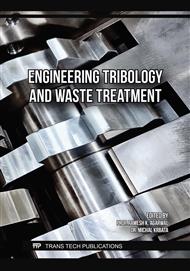[1]
Raghu Raman Rajagopal, Ravindra Rajarao, Sagar T. Cholake and Veena Sahajwalla: Sustainable composite panels from non-metallic waste printed circuit boards and automotive plastics: J. Cleaner Prod. Vol. 144 (2017), pp.470-481.
DOI: 10.1016/j.jclepro.2016.12.139
Google Scholar
[2]
Michelina Soccio, Franco Dominici, Silvia Quattrosoldi, Francesca Luzi, Andrea Munari, Luigi Torre, Nadia Lotti, and Debora Puglia: PBS-Based Green Copolymer as an Efficient Compatibilizer in Thermoplastic Inedible Wheat Flour/Poly(butylene succinate) Blends: Biomacromolecules Vol. 21 (2020), pp.3254-3269.
DOI: 10.1021/acs.biomac.0c00701
Google Scholar
[3]
Haw-Ming Huang: Medical Application of Polymer-Based Composites: Polymers Vol. 12 (2020) : 2560;.
DOI: 10.3390/polym12112560
Google Scholar
[4]
He-yang Li, Dan-ni Huang, Ke-feng Ren, and Jian Ji: Inorganic-polymer composite coatings for biomedical devices: Smart Mater. Med. Vol. 2 (2021), pp.1-14.
Google Scholar
[5]
Pornsri Pakeyangkoon and Benjawan Ploydee: Mechanical Properties of Acrylate-Styrene- Acrylonitrile/Bagasse Composites: Adv. Mater. Res. Vol. 747 (2013), pp.355-358.
DOI: 10.4028/www.scientific.net/amr.747.355
Google Scholar
[6]
Shuangqiao Yang, Shibing Bai and Qi Wang: Morphology, mechanical and thermal oxidative aging properties of HDPE composites reinforced by nonmetals recycled from waste printed circuit boards: Waste Manage. Vol. 57 (2016), pp.168-175.
DOI: 10.1016/j.wasman.2015.11.005
Google Scholar
[7]
Shuangqiao Yang, Shibing Bai and Qi Wang: Preparation of fine fiberglass-resin powders from waste printed circuit boards by different milling methods for reinforcing polypropylene composites: J. Appl. Polym. Sci. Vol. 132 (2015), 42494 (1-8).
DOI: 10.1002/app.42494
Google Scholar
[8]
Shenghui Tian, Hui He, Peng Yu, Ling Zhou, Yuanfang Luo and Demin Jia: Sustainable utilization of waste printed circuit boards powders in HDPE-wood composites: Synergistic effects of multicomponents on structure and properties: J. Cleaner Prod. Vol. 164 (2017), pp.840-847.
DOI: 10.1016/j.jclepro.2017.07.011
Google Scholar
[9]
Jiuyong Guo, Jie Guo and Zhengming Xu: Recycling of non-metallic fractions from waste printed circuit boards: A review: J. Hazard. Mater. Vol. 168 (2009), pp.567-590.
DOI: 10.1016/j.jhazmat.2009.02.104
Google Scholar
[10]
Xinjie Wang, Yuwen Guo, Jingyang Liu, Qi Qiao and Jijun Liang: PVC-based composite material containing recycled non-metallic printed circuit board (PCB) powders: J. Environ. Manage. Vol. 91 (2010), pp.2505-2510.
DOI: 10.1016/j.jenvman.2010.07.014
Google Scholar
[11]
A. Kausar: Advances in Carbon Fiber Reinforced Polyamide-Based Composite Materials: Advances in Materials Science Vol. 19 (2019), pp.67-82.
DOI: 10.2478/adms-2019-0023
Google Scholar
[12]
Johnny N. Martins, Tobias G. Klohn, Otavio Bianchi, Rudinei Fiorio and Esteva˜o Freire: Dynamic mechanical, thermal, and morphological study of ABS/textile fiber composites: Polym. Bull. Vol. 64 (2010), pp.497-510.
DOI: 10.1007/s00289-009-0200-6
Google Scholar
[13]
Sarawut Rimdusit, Patima Wongmanit, Siriporn Damrongsakkul, Duangporn Saramas, Chanchira Jubsilp, and Isala Dueramae: Characterizations of Poly(vinyl chloride)/Acrylonitrile Styrene Acrylate Blends for Outdoor Applications: Eng. J. Vol. 18 (2014), pp.105-118.
DOI: 10.4186/ej.2014.18.1.105
Google Scholar
[14]
Beata Podko´scielna, Krystyna Wnuczek, Marta Goliszek, Tomasz Klepka and Kamil Dziuba: Flammability Tests and Investigations of Properties of Lignin-Containing Polymer Composites Based on Acrylates: Molecules Vol. 25(24) (2020), 5947.
DOI: 10.3390/molecules25245947
Google Scholar
[15]
Mahadev Bar, R. Alagirusamy, and Apurba Das: Flame Retardant Polymer Composites: Fibers Polym. Vol. 16(4) (2015), pp.705-717.
DOI: 10.1007/s12221-015-0705-6
Google Scholar
[16]
Rapeephun Dangtungee, Jimmy Yun and Pitt Supaphol: Melt rheology and extrudate swell of calcium carbonate nanoparticle-filled isotactic polypropylene: Polym. Test. Vol. 24 (2005), pp.2-11.
DOI: 10.1016/j.polymertesting.2004.08.006
Google Scholar


